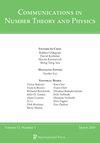瞬子分割函数系数的数值实验
IF 1.2
3区 数学
Q1 MATHEMATICS
引用次数: 0
摘要
我们分析了四曲面上瓦法-维滕(VW)理论的分区函数系数。这些分割函数因子化为一个枚举点状瞬子的函数和一个枚举光滑瞬子的函数的乘积。对于 gauge group $SU(2)$ 和 $SU(3)$ 以及四芒星复射平面 $m\mathbb{CP}^2$,我们通过实验研究了后一种函数,它们分别是深度为 1 美元、权重为 3/2 美元和深度为 2 美元、权重为 3 美元的模拟模态的例子。我们还引入了 "模拟尖顶形式 "的概念,并研究了与$SU(3)$分割函数相关的权重为3$的例子。对这些模拟模块形式的前 200 个系数进行的数值实验表明,对于各自的权重 $k = 3/2$ 和 $3$,这些函数的系数增长为 $O(n^{k-1})$。这种增长与权重为 $k$ 的模态类似。另一方面,权重为$3$的模拟尖顶形式的系数似乎增长了$O(n^{3/2})$,超过了权重为$3$的经典尖顶形式的增长。我们利用鞍点分析法给出了界限,但这在很大程度上超出了实验观察结果。本文章由计算机程序翻译,如有差异,请以英文原文为准。
Numerical experiments on coefficients of instanton partition functions
We analyze the coefficients of partition functions of Vafa–Witten (VW) theory on a four-manifold. These partition functions factorize into a product of a function enumerating pointlike instantons and a function enumerating smooth instantons. For gauge groups $SU(2)$ and $SU(3)$ and four-manifold the complex projective plane $\mathbb{CP}^2$, we experimentally study the latter functions, which are examples of mock modular forms of depth $1$, weight $3/2$, and depth $2$, weight $3$ respectively. We also introduce the notion of “mock cusp form”, and study an example of weight $3$ related to the $SU(3)$ partition function. Numerical experiments on the first 200 coefficients of these mock modular forms suggest that the coefficients of these functions grow as $O(n^{k-1})$ for the respective weights $k = 3/2$ and $3$. This growth is similar to that of a modular form of weight $k$. On the other hand the coefficients of the mock cusp form of weight $3$ appear to grow as $O(n^{3/2})$, which exceeds the growth of classical cusp forms of weight $3$. We provide bounds using saddle point analysis, which however largely exceed the experimental observation.
求助全文
通过发布文献求助,成功后即可免费获取论文全文。
去求助
来源期刊

Communications in Number Theory and Physics
MATHEMATICS, APPLIED-MATHEMATICS
CiteScore
2.70
自引率
5.30%
发文量
8
审稿时长
>12 weeks
期刊介绍:
Focused on the applications of number theory in the broadest sense to theoretical physics. Offers a forum for communication among researchers in number theory and theoretical physics by publishing primarily research, review, and expository articles regarding the relationship and dynamics between the two fields.
 求助内容:
求助内容: 应助结果提醒方式:
应助结果提醒方式:


